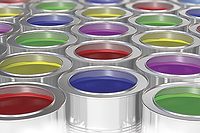The Search for Exxate Fluids Replacements for Solventborne Coatings



What are Exxate Solvents?
The Exxate line of solvents includes those noted above. Each Exxate solvent is composed of a mixture of branched and linear alkyl acetates. They are commonly referred to as oxo-alkyl acetates. The number in the Exxate solvent name refers to the number of carbons on the alkyl chain of the ester. Exxate 600 is a mixture of six carbon alkyl acetate esters, Exxate 700 a mixture of primarily seven carbon alkyl acetate esters, and so on.
Use of Exxate Solvents in Solventborne Coatings
Important criteria for solvent selection in solventborne coatings include solvency, ability to reduce coating resin viscosity, evaporation rate, density, odor, regulatory status, cost and other factors, depending on application. Since Exxate solvents are mainly used as the slow or "tail" solvent in coatings, it is most critical to match the evaporation rate as closely as possible. The "tail" solvent slows the drying of the coating, allowing time for it to flow and level, thereby improving the film appearance.
A blend of 80% n-propyl propionate and 20% n-butyl propionate has the same predicted RER as the blend above, but the evaporation profile match is superior (Figure 2).

Therefore, water solubility of a solvent should be considered when choosing replacements for coatings that will be cured at various environmental conditions.

Recommended Replacements
Recommendations for each Exxate fluid include at least one single solvent recommendation and, for some, a selection of blends. The single solvent recommendation is the closest match based on RER and Hansen solubility parameters. A selection of blends is listed to offer choices that cover various performance, regulatory and cost requirements. For some formulations, these recommendations may offer a direct substitute. However, depending on requirements, adjustment of the solvent blend may be required to achieve the proper solvent balance. Replacement recommendations are based on single solvents and solvent blends that best match evaporation profiles.
CHEMCOMP allows the evaporation profiles to be predicted with various temperature and relative humidity. Conditions in the figures are 25 °C and 50% relative humidity unless otherwise noted.

Exxate 600
A commercially available replacement exists for Exxate 600 that is nearly identical in structure and properties. Comparison of the chemical structure shows that n-pentyl propionate is an isomer of the four components of Exxate 6003 (See Figure 4).Table 1 shows the physical properties to be nearly identical. The small differences can be attributed to the fact that most of the Exxate 600 isomers contain branched alkyl groups while UCAR n-Pentyl Propionate contains only linear alkyls. In addition to flash point, evaporation rate and solubility parameters, the table also shows other useful characteristics such as:
- Water solubility - an important factor for water-sensitive formulations or to predict the impact of relative humidity on drying;
- Density - higher-density solvents will contribute more volatile organic chemicals (VOC) for an equivalent volume;
- Surface tension - an important factor for some applications such as plastic coatings;
- HAP - HAP (Hazardous Air Pollutant) status as defined by the U.S. EPA Resistivity - important for electrostatically applied coatings.


Abbreviations and supplier nomenclature:
EEP = ethyl 3-ethoxy propionateUCAR4 Ester EEP, EASTMAN5 EEP Solvent
2-EHAc = 2-ethylhexyl acetate
PGDA = propylene glycol diacetate
DOWANOL6 PGDA,
EBA = ethylene glycol butyl glycol ether acetate
Butyl CELLOSOLVE7 acetate, EASTMAN EB acetate, glycol ether EB acetate
n-BuAc = n-butyl acetate
DPMA = dipropylene glycol methyl ether acetate
DOWANOL DPMA, ARCOSOLV8 DPMA
IBHK = isobutyl heptyl ketone
ECOSOFT9 Solvent IK
DBA = diethylene glycol butyl ether acetate
Butyl CARBITOL10 acetate, EASTMAN DB acetate, glycol
ether DB acetate
TPMB = 2,2,4-trimethyl-1,3-pentanediol monoisobutyrate
UCAR Filmer IBT, TEXANOL11 Ester Alcohol
Exxate 700
Exxate 800
Exxate 900
Exxate 1000
Exxate 1200 and 1300
Note: Evaporation rate profile comparison for Exxate 1200 is currently unavailable in the CHEMCOMP database due to the unavailability of physical property data.

Summary
There are several options available to the coatings formulator for replacing Exxate solvents. Whether the solution is a direct replacement or requires adjusting the solvent balance, formulators have many options in order to maintain product performance and cost effectiveness.
References
1 Exxate is a trademark of ExxonMobil Chemical Co.
2 CHEMCOMP is a Service Mark of The Dow Chemical Co.
3 Carter, W.P.L. (2000). Atmospheric Ozone Impacts of Exxsol D95, Isopar M and the Exxate fluids. Final Report. ExxonMobil. RT3L.
4 UCAR is a trademark of The Dow Chemical Co.
5 EASTMAN is a trademark of The Eastman Chemical Co.
6 DOWANOL is a trademark of The Dow Chemical Co.
7 CELLOSOLVE is a trademark of The Dow Chemical Co.
8 ARCOSOLV is a trademark of Lyondell Chemical Co.
9 ECOSOFT is a trademark of The Dow Chemical Co.
10 CARBITOL is a trademark of The Dow Chemical Co.
11 TEXANOL is a trademark of Eastman Chemical Co.
Looking for a reprint of this article?
From high-res PDFs to custom plaques, order your copy today!






